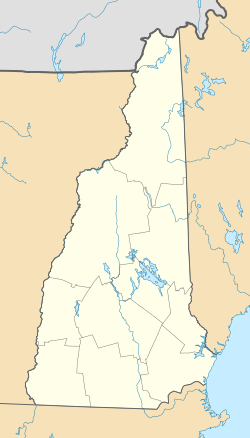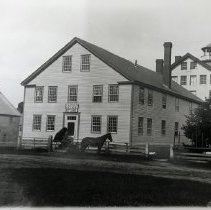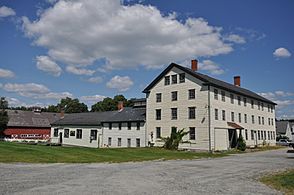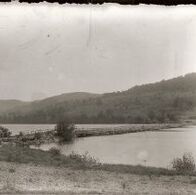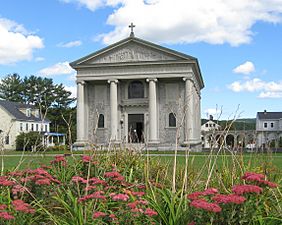Enfield Shaker Museum facts for kids
Quick facts for kids |
|
|
Enfield Shaker Historic District
|
|

The Great Stone Dwelling, Mary Keane Chapel and West Brethren Shop (right to left)
|
|
| Location | NH Route 4A, Enfield, New Hampshire, U.S. |
|---|---|
| Area | 1,235 acres (500 ha) |
| NRHP reference No. | 79000198 |
| Added to NRHP | November 7, 1979 |
| Community | Enfield Shaker Village, New Hampshire |
|---|---|
| Dates | 1793-1923 |
| Bishopric | Canterbury |
| Spiritual name | Chosen Vale |
| Families | Church, North, South |
| Maximum population | 297 in 1840 |
The Enfield Shaker Museum is a special outdoor museum in Enfield, New Hampshire. It helps us learn about the Shakers, a religious group who lived there for many years. They lived on this land from 1793 to 1923.
The museum shows old Shaker buildings, tools, and beautiful gardens. It sits in a valley between Mount Assurance and Mascoma Lake. One of its most famous buildings is the Great Stone Dwelling. This was the biggest home north of Boston at the time.
When the Shakers left, much of their land was sold. Today, the state owns 28 acres and 13 buildings. This area is now the Enfield Shaker Museum.
Contents
Discovering the Enfield Shakers
The Shaker Village Story
The Shakers were also known as the United Society of Believers in Christ's Second Appearing. They made their home in Enfield in 1793. Their village grew to cover about 1,200 acres along Lake Mascoma.
They built a meetinghouse in May 1793 and a home in 1794. Later buildings were made from strong granite. The Shakers used advanced stone building methods for their time. By 1803, there were 132 members in the village. The community grew to almost 300 people by 1840.
The Great Stone Dwelling
The Great Stone Dwelling was the largest Shaker building ever built. It was also the biggest residential building north of Boston. It was built for the Church Family between 1837 and 1841.
This huge building had four full floors and six stories in total. Men and women lived there but had separate entrances and living areas. Ammi Burnham Young designed the building. He also designed Vermont's second state capitol building.
Skilled stonemasons from Boston built the granite exterior and slate roof. The Shaker brothers themselves built the rest of the building.
Shaker Life and Work
In 1849, the Shakers built the Shaker Bridge. It was half a mile long and crossed a narrow part of Lake Mascoma. This bridge connected them to the railroad line. In 1870, they built the Ministry shop. This beautiful building housed the community's religious leaders.
The Shakers were very good at making things. They made brooms, buckets, and spinning wheels. They also produced applesauce, maple syrup, and herbal medicines. They sold seeds and shirts to support their community.
The Village Closes
Like many other Shaker communities, the Enfield village slowly became smaller. In 1923, the Enfield Shaker village closed. The remaining members moved to the Canterbury Shaker Village in central New Hampshire.
In 1927, much of the village property was sold. Today, the site is recognized as the Enfield Shaker Historic District. It is listed on the U.S. National Register of Historic Places.
Visiting the Museum Today
Since 1986, the Enfield Shaker Museum has worked to save the Shaker history. It also shares the village's story from the 20th century. The Great Stone Dwelling is now home to the gift shop and main exhibits.
The museum is open every day. You can take tours of the site and even stay overnight. You can sleep in the original Shaker bedrooms of the Great Stone Dwelling.
There are 13 Shaker village buildings and gardens on 28 acres. You can explore them on a self-guided walking tour. The state of New Hampshire owns this village museum.
The Missionaries of La Salette
In 1927, the site was sold to the Missionaries of La Salette. This group turned the village into a seminary for Catholic priests. It also became a school and a place for meetings.
In 1930, the La Salettes built the Mary Keane Chapel. This chapel has a neo-classical revival style. It is now part of the museum and visitors can see it. The Missionaries of La Salette closed the seminary in 1974. The center is now known as the Shrine of Our Lady of La Salette. It is a place for "reconciliation."
In 2020, the Missionaries of La Salette announced they would close their Enfield operations. This included the Marian shrine on Mount Assurance. The Enfield Shaker Museum bought the shrine and all the land in July 2023.
See also
- Enfield Village Historic District
- National Register of Historic Places listings in Grafton County, New Hampshire
- New Hampshire Historical Marker No. 202: The Enfield Shakers
- Shaker Seed Company
- Thomas Corbett (Shaker doctor)


